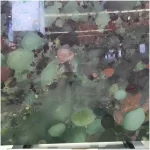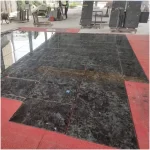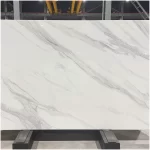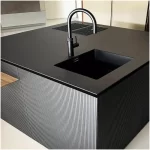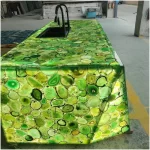Analysis of the causes of marble efflorescence and corresponding preventive measures
1. Stone protective liquid is not applied.
Precautionary measures: When signing a contract with a stone factory, first of all, it is necessary to make sure that the sheet material needs to be protected by six sides, and the protective liquid should pass the quality.
The stone should be kept clean and dry before applying the protective agent.
The number of painting passes and the thickness of the brush should be up to standard, and the brushing part should be completely leaked.
After painting, it should be protected from rain.
After the stone arrives, it can be sampled and watered for protection performance inspection.
2. During the construction on site, the integrity of the original protection is destroyed due to the breakage or cutting of the sheet.
Precautionary measures: When working on site, prepare protective fluid. For fracture repair or cutting stone, the protective fluid should be brushed to ensure the overall integrity of the protection. Otherwise, the water will enter the interior of the stone along the cracks and loose parts of the stone, so that the humidity of the stone will increase, thereby forming a vicious circle, and ubiquitin will appear over time.
3. The surface water is too much, and the stone is in a humid or polluted environment for a long time, causing water to invade the stone through the protective layer.
Precautionary measures: 1 If the paved stone is in a dark and humid environment or even a heavy water vapor, if you are not sure, you should first make a sample. 2 Do not pour a lot of water on the stone before the operation. 3 A moisture barrier should be installed under the ground wall. If the floor of the water room such as the bathroom or bathroom is decorated with stone, it should be treated with anti-seepage treatment.
4. Some stone materials are soft or have large holes. When used as ground stone, although they are also protected by six sides before construction, due to the characteristics of such stones, they are soft and have many holes. The effect is generally not very good, the alkaline substances in the cement sand will be easy to precipitate.
Precautionary measures: Stones with soft stone materials such as French wood grain and stones with more holes such as beige travertine are often encountered. When constructing ground materials, we generally use white cement instead of black cement. Although the strength and viscosity of white cement is a little worse than that of black cement, the difference in the composition of the two materials, white cement used to paste the ground stone, through the back of the stone, can form a good seal on the back of the stone, and the stone and The precipitates between the stone slabs are also faded by white, effectively preventing efflorescence.

